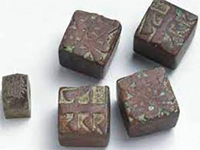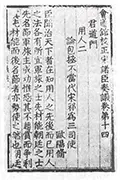Movable Type Printing in China
Printing with wood blocks was a Chinese invention that dated to the Han period, in the 3rd Century. At that time, printers used silk and other cloth for their production. It was during the Tang period in China, about the 7th Century, that printing on paper using wood blocks became relatively common. 
To start with, the "writer" would use ink to create whatever needed to be copied on a sheet of fine paper. For the sake of efficiency, writers would fill the sheet of paper with characters, line by line. The next step was to press the sheet of paper to a wood block that had been coated with rice paste. Doing this transferred the inked images to the wood, and the consistency of the paste coating the wood was such that the paper did not stick to the wood. The characters on the sheet of paper, however, did stick to the wood, after a fashion, especially once the printer had used a strong brush to press the paper to the wood. The result was an entire page of printed characters. The wood block could be used again and again, to create more and more printings of the same thing. In this way Chinese printers adopted a form of mass production. Such a process was still time-consuming. As desirable as being able to reproduce individual pages was, it still resulted in only one thing at a time. If a printer wanted to print something else, then he had to produce yet another set of carvings, pages, etc. 
It was the engineer Bi Sheng, about 1040, who developed the first system of movable type for printing. This was during the Song Dynasty (and was recorded by the scholar Shen Kuo in his Dream Pool Essays). The printer's method was to carve one character into a clay block just large enough to hold that character and then repeat the process with another character, into another clay block, and so on. The idea was to still print one full page at a time; however, the printer could use paste to affix many clay blocks to one sheet of iron plate and could move each individual clay block if needed. In essence, a printer could change one character and be able to create a new page in just a few minutes; using the previous process, such a need could be filled only after a handful of hours. A printer would create such clay blocks with characters carved into them and keep a collection of the blocks in a wooden case, removing each individual clay block as needed and then keeping it safe in the case when not needed. Bi Sheng had first used one-character wood blocks as movable type but had abandoned wood because he found it too difficult to use for the purpose. Two centuries later, Wang Zhen, a royal official during the Yuan Dynasty, improved on Bi Sheng's wood block movable type method and eventually created more than 30,000 wooden blocks of movable type. 
Wang Zhen mentioned in one of the books that he printed this way that other Chinese printers used blocks of metal, such as bronze, copper, or tin, for printing. Later printers working in subsequent dynasties more and more depended on metal blocks for movable type. The idea of movable type spread to other countries, first in Asia and then in Europe. The Japanese and Korean civilizations used movable type to print materials beginning in the 13th (Korea) and 16th (Japan) Centuries. In between came the movable type printing press perfected by the European printer Johannes Gutenberg. |
|
Social Studies for Kids
copyright 2002–2024
David White




